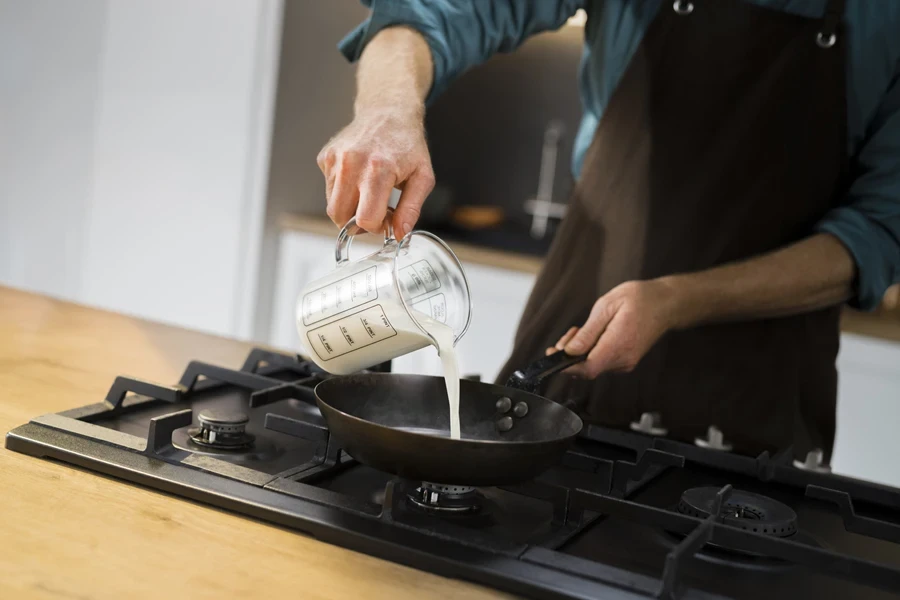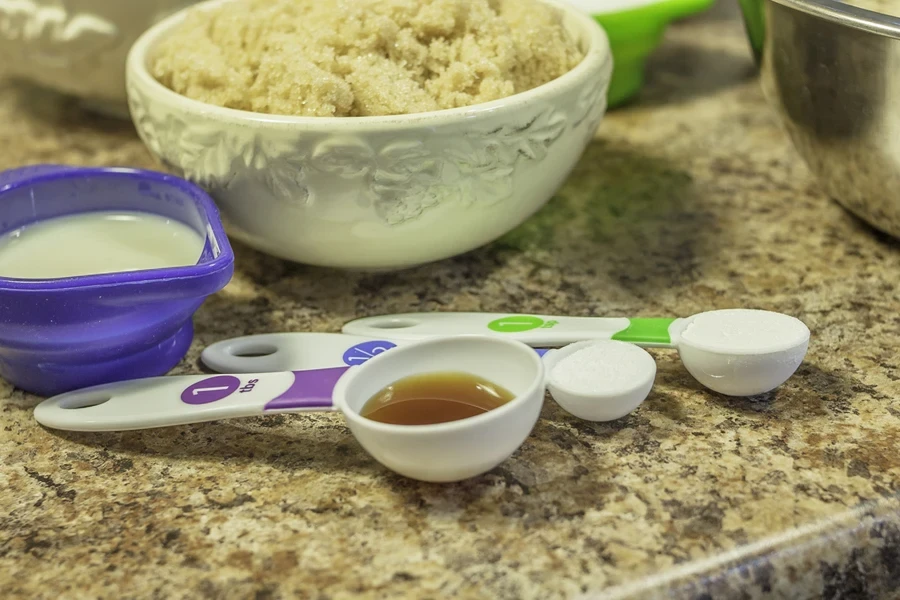Accuracy is vital when baking and cooking, so knowing how many ounces (oz) in a cup will meet recipe instructions is important when you don’t have other kitchen tools. This is especially true if you don’t want to waste valuable ingredients due to a miscalculation and end up with a vile-tasting result that should have been delicious.
But what do you do when you find a favorite recipe online that uses the metric system, and you live in the United States? Or you have no clue how to convert the imperial system for precise measurements because you are in the United Kingdom?
Before you produce another throwaway sauce or cake, you need help. Here, we show you exactly how many ounces are in a cup and provide easy conversion charts for measuring dry and wet ingredients. After reading this article, you should never experience another measurement conversion disaster in the kitchen.
Table of Contents
Liquid measurement conversion guidelines
Choosing liquid measurement kitchen tools
Tips for measuring liquids correctly
Stock up on the best when converting oz into cups
Liquid measurement conversion guidelines

When you find a delicious recipe for muffins, a chocolate cake, or a tasty dinner, there’s no time to waste with metric to universal conversions and vice versa. You want to get going with the job to impress your friends or family members, but you also don’t want your efforts to flop.
If you’ve been in this situation, we appreciate the dilemma. Because we’re on your side, we’ve simplified the conversion from the metric to the imperial system. This conversion is often necessary and welcome, as not all cooking tools feature both standard volumes and metric measurements.
Fortunately, this chart solves the standard volume vs. metric conversion problem once and for all. Keep it close at all times to work out the right liquid measurements for every recipe you prepare.
| Metric to US Measurements | ||||||
| Milliliters = | Teaspoons + | Tablespoons | Metric Cups = | Fluid Ounces = | Pint = | Quarts |
| 0.5 | ⅛ | |||||
| 1 | ¼ | |||||
| 2 | ⅓ | |||||
| 5 | 1 | |||||
| 15 | 1 | |||||
| 25 | 2 | 1 | ||||
| 50 | ¼ | 2 | ||||
| 75 | ⅓ | 3 | ||||
| 125 | ½ | 4 | ||||
| 150 | ⅔ | 5 | ||||
| 175 | ¾ | 6 | ||||
| 250 | 1 | 8 | ||||
| 500 | 2 | 1 | ||||
| 1,000 (1 Liter) | 4 | 2 | 1 | |||
Teaspoon and tablespoon recipe conversions
When you want to focus on putting a whole lot of love into a recipe, you want to avoid the distraction of converting teaspoons and tablespoons. The chart below will help you to quickly double, triple, quadruple, or halve ingredient measurements. With this handy chart in the kitchen, you don’t need special tools or use guesswork, which can quickly go awry. Instead, use precision for the desired result so everyone is happy.
| Cups Conversion Chart | ||
| Teaspoons | Tablespoons | Metric Cups |
| 3= | 1 | |
| 4= | ¼ | |
| 1+ | 5= | ⅓ |
| 8= | ½ | |
| 2+ | 10= | ⅔ |
| 12= | ¾ | |
| 16= | 1 | |
More liquid measurement conversions
When liquid measurements become even more complex and include fluid ounces (fl oz), quartz, and gallons, another chart should help you rise to the challenge.
| Liquid Conversions from Tablespoons to Gallons | |||||
| Tablespoons | Cups | Fluid Ounces | Pints | Quarts | Gallons |
| 1= | ½ | ||||
| 1= | 8= | ½ | |||
| 2= | 16= | 1 | |||
| 4= | 32= | 2= | 1 | ||
| 16= | 128= | 8= | 1 | ||
Choosing liquid measurement kitchen tools

Using the things you have in your kitchen to convert liquid measurements between systems is practical. However, if you have the right tools for the job, things immediately become that much easier. When you’re ready to equip your kitchen with the best liquid measuring items to save time and hassle, you will need the following:
Measuring jugs: These products are made from clear glass, plastic, or stainless steel and often have metric and imperial measurements on the side. Choose measuring jugs with sturdy handles and a good pouring spout that can measure between 1 and 8 cups of liquid.
Liquid measuring cups: Choose a set of liquid measuring cups made from stainless steel or plastic. The set should have conversions for 1/4 to 1 cup of liquid. These cups are ideal for measuring liquid ounces of water, a cup of water, milk, or olive oil, although a spoon may be better for olive oil, depending on how much is needed.
Do not confuse the liquid measuring cups with dry ingredient tools or use them interchangeably, as the wrong tool can easily lead to an inaccurate ingredient measurement.
Dry measuring cups: Use special dry measurement cups for grams or cups of sugar, flour, and other dry ingredients.
Measuring spoons: Look for nesting measuring spoons with ¼, ½, 1 teaspoon, and 1 tablespoon measurements. You can use this type of product to measure wet and dry ingredients. These products are typically made from stainless steel, plastic, or wood.
Mixing bowls and baking pans: You don’t need measuring tools much unless you have some great mixing bowls in the kitchen. Of course, you also need mixing spoons and whisks for baking when figuring out how many oz are in a cup. But baking pans are equally necessary if you want a well-stocked kitchen.
Cake mixers: Automatic or electric cake mixers are always welcome in the kitchen, but sometimes you need an electric hand mixer or bread maker to go with your measuring spoons.
Kitchen scale: A kitchen scale is the right way to go if you bake regularly. You can find manual kitchen scales online or go for digital kitchen scales, which are both popular.
Calculator: A dedicated calculator in the kitchen is always helpful when you need to make a simple formula change for a standard measurement conversion or between systems if you don’t have the right tools.
Tips for measuring liquids correctly

Always set the container down on a flat surface. When pouring the liquid into the container, do it at eye level for an accurate outcome. You may believe that you have enough experience to measure haphazardly from a different angle, but one mistake could cost you an entire set of ingredients. If you want the correct measurement, do it right the first time.
Accurate measurements are particularly critical when baking, especially when halving or tripling recipes. Calculations for dry and liquid ingredients can quickly fall apart, and before you realize the mistake, you’re adding more liquid or dry ingredients to try and rectify the situation.
Instead, use the helpful conversion chart above or buy the right kitchen measuring tools to avoid unnecessary errors, and always fill the spoons, cups, or jugs to the maximum point shown in the recipe.
Answers to some questions
- The US fluid ounce is approximately 4% more than the imperial fluid ounce and is precisely 30 milliliters.
- The weight of one stick of butter is ¼ pound, 4 ounces, or 110 grams.
- Liquid volumes of measurement include milliliters, liters, teaspoons, tablespoons, liquid ounces, cups, pints, quarts, and gallons.
- The difference between dry and fluid ounces is that you use dry ounces to measure dry ingredients like brown sugar or flour. In contrast, you use fluid ounces to measure liquid ingredients.
Stock up on the best when converting oz into cups

For avid bakers and budding chefs, the right measuring tools and kitchen equipment are designed to simplify your work and boost performance. We strongly recommend shopping at Alibaba.com for all your kitchen equipment to support your quest for excellence.
Browse all the baking tools available, build relationships with the suppliers, and then place your orders. Whether you’re shopping as an individual or a seller, there is so much to see and buy to get your or your customer’s kitchens up to the master chef level. What better time to start shopping than right now?




